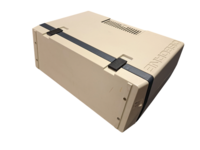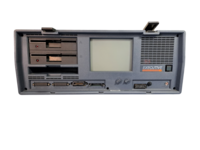Osborne Executive
| Home > Browse Our Collection > Computers > Osborne > Osborne Executive |
|
The Osborne Executive is the much improved model of the Osborne 1 Portable, it has a 7 inch amber phosphor screen, and half height 5.25 disk drives, now mounted on top of each other, rather than on each side of the smaller 5 inch screen of the original. This made the machine lighter than the old machine by a couple of kilos. It came with application software, Wordstar, the Supercalc spreadsheet, and CBASIC and MBASIC programming languages. This made the machine very competitive in the market, as this was the latest software, retailing with the machine for $2,495. The case is very similar to the squared off revision of the previous machine, with the keyboard once again covering the front of the machine and attached by a cable. The machine also has a cooling fan and an air filter under the much smaller carry handle at the rear of the machine. The case of the Executive is very similar to that of the revised Osborne 1, with the keyboard acting as both a cover for the display and disk drives as well as a stand for the main unit. Unlike the Osborne 1, the Executive features a cooling fan and air filter underneath the rear case carry-handle. The operating system is CP/M version 3.0, this version allows any compatible program the use of more RAM. There is also an alternative operating system UCSD m-System uncluded in the package. The Osborne Executive was very short lived, and supposed to be a holding product until the company had produced a new, promised machine, that would have been considerably more powerful than the original. The company had announced it too soon, and had done almost nothing to bring it to the drawing board, let alone the market. This process is now known as the Osborne effect, announcing a new product too soon to the detriment of one already on the market.
Manufacturer: Osborne Comment on This Page Other Systems Related To Osborne Executive:
This exhibit has a reference ID of CH74047. Please quote this reference ID in any communication with the Centre for Computing History. |
|














